Strategic Human Resource Management: Performance Related Pay Analysis
VerifiedAdded on 2020/06/06
|10
|3280
|33
Report
AI Summary
This report provides a comprehensive analysis of Strategic Human Resource Management (SHRM), focusing on the critical evaluation of individual performance in relation to pay. It explores the concepts of performance-related pay (PRP) and its connection to employee motivation, referencing various academic sources like Armstrong and Taylor, Boxall and Purcell, and Budhwar and Debrah. The report discusses the advantages and disadvantages of PRP schemes, including their alignment with organizational goals, objectivity in measuring performance, and potential for demotivation if goals are not met. It also examines the role of PRP in promoting equality and justice, as well as its impact on employee engagement, trade unions, and flexible working arrangements. Furthermore, the report explores different reward management strategies, such as CEO for the day, lunch with the boss, team shopping sprees, themed team lunches, company apparel, team service projects, thank you meetings, certificates of achievement, jeans day, and holiday offers, to enhance employee motivation and improve performance within an organization. The report concludes by emphasizing the importance of aligning PRP with broader organizational objectives and addressing potential drawbacks such as discrimination and the creation of a blame culture.
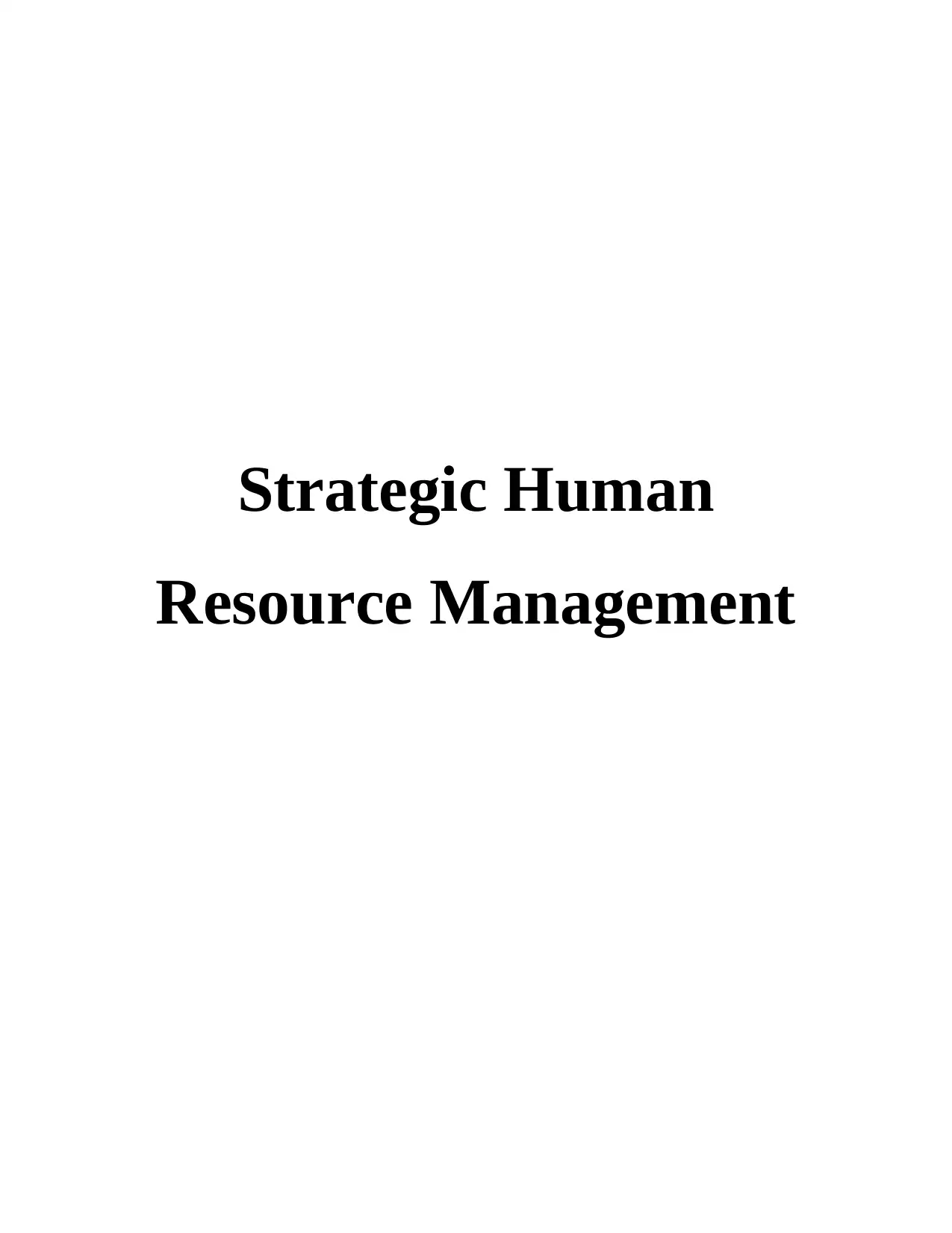
Strategic Human
Resource Management
Resource Management
Paraphrase This Document
Need a fresh take? Get an instant paraphrase of this document with our AI Paraphraser
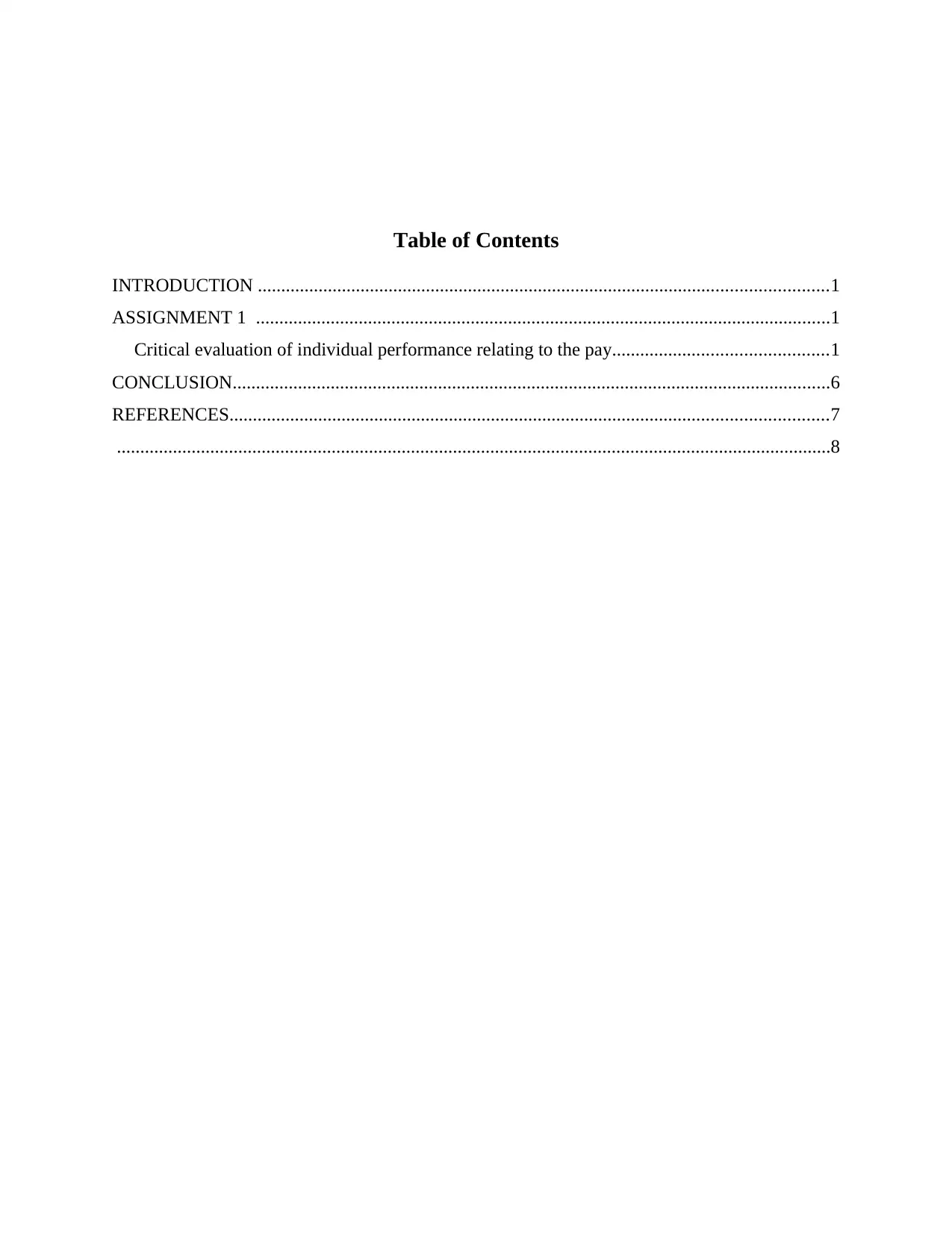
Table of Contents
INTRODUCTION ..........................................................................................................................1
ASSIGNMENT 1 ...........................................................................................................................1
Critical evaluation of individual performance relating to the pay..............................................1
CONCLUSION................................................................................................................................6
REFERENCES................................................................................................................................7
.........................................................................................................................................................8
INTRODUCTION ..........................................................................................................................1
ASSIGNMENT 1 ...........................................................................................................................1
Critical evaluation of individual performance relating to the pay..............................................1
CONCLUSION................................................................................................................................6
REFERENCES................................................................................................................................7
.........................................................................................................................................................8
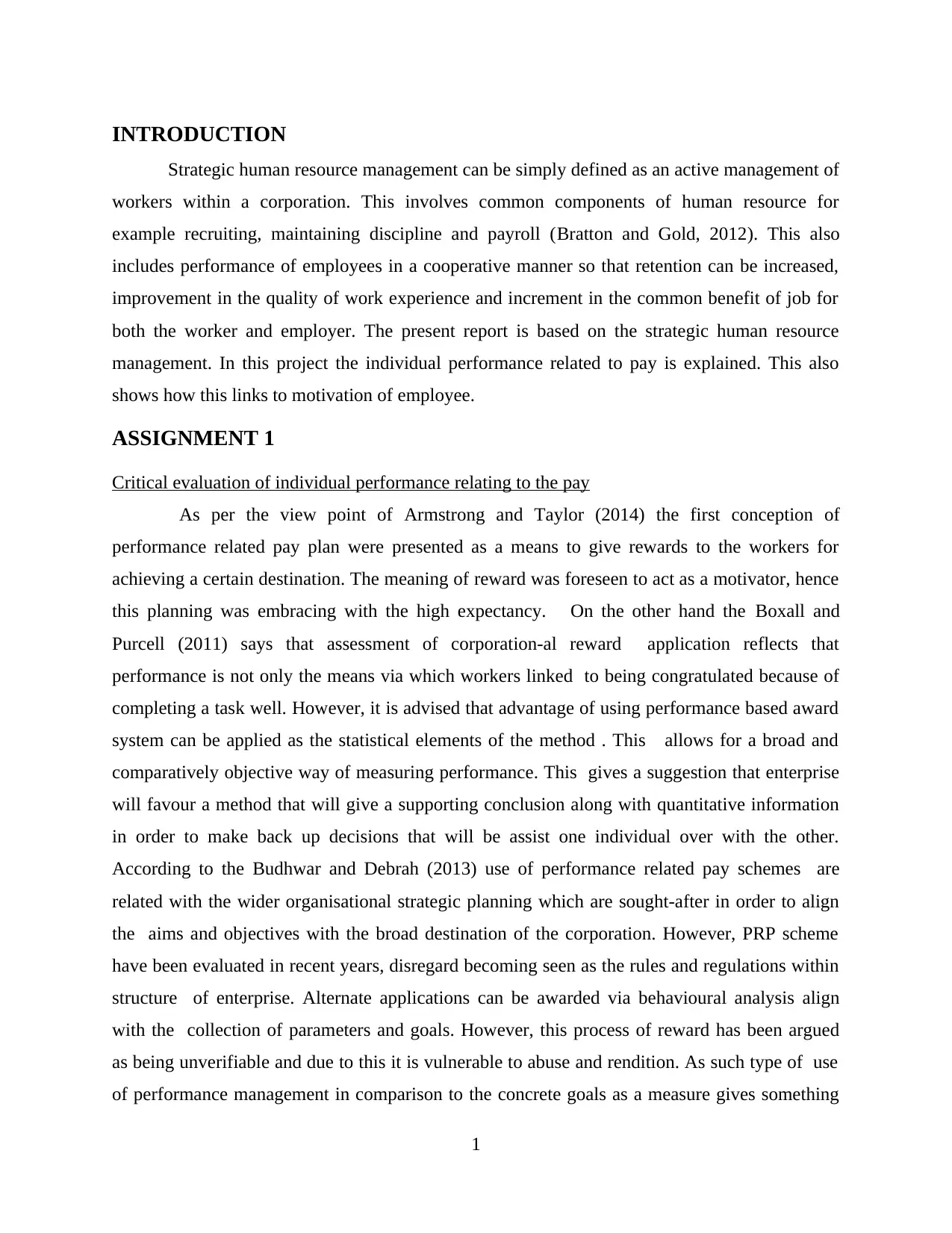
INTRODUCTION
Strategic human resource management can be simply defined as an active management of
workers within a corporation. This involves common components of human resource for
example recruiting, maintaining discipline and payroll (Bratton and Gold, 2012). This also
includes performance of employees in a cooperative manner so that retention can be increased,
improvement in the quality of work experience and increment in the common benefit of job for
both the worker and employer. The present report is based on the strategic human resource
management. In this project the individual performance related to pay is explained. This also
shows how this links to motivation of employee.
ASSIGNMENT 1
Critical evaluation of individual performance relating to the pay
As per the view point of Armstrong and Taylor (2014) the first conception of
performance related pay plan were presented as a means to give rewards to the workers for
achieving a certain destination. The meaning of reward was foreseen to act as a motivator, hence
this planning was embracing with the high expectancy. On the other hand the Boxall and
Purcell (2011) says that assessment of corporation-al reward application reflects that
performance is not only the means via which workers linked to being congratulated because of
completing a task well. However, it is advised that advantage of using performance based award
system can be applied as the statistical elements of the method . This allows for a broad and
comparatively objective way of measuring performance. This gives a suggestion that enterprise
will favour a method that will give a supporting conclusion along with quantitative information
in order to make back up decisions that will be assist one individual over with the other.
According to the Budhwar and Debrah (2013) use of performance related pay schemes are
related with the wider organisational strategic planning which are sought-after in order to align
the aims and objectives with the broad destination of the corporation. However, PRP scheme
have been evaluated in recent years, disregard becoming seen as the rules and regulations within
structure of enterprise. Alternate applications can be awarded via behavioural analysis align
with the collection of parameters and goals. However, this process of reward has been argued
as being unverifiable and due to this it is vulnerable to abuse and rendition. As such type of use
of performance management in comparison to the concrete goals as a measure gives something
1
Strategic human resource management can be simply defined as an active management of
workers within a corporation. This involves common components of human resource for
example recruiting, maintaining discipline and payroll (Bratton and Gold, 2012). This also
includes performance of employees in a cooperative manner so that retention can be increased,
improvement in the quality of work experience and increment in the common benefit of job for
both the worker and employer. The present report is based on the strategic human resource
management. In this project the individual performance related to pay is explained. This also
shows how this links to motivation of employee.
ASSIGNMENT 1
Critical evaluation of individual performance relating to the pay
As per the view point of Armstrong and Taylor (2014) the first conception of
performance related pay plan were presented as a means to give rewards to the workers for
achieving a certain destination. The meaning of reward was foreseen to act as a motivator, hence
this planning was embracing with the high expectancy. On the other hand the Boxall and
Purcell (2011) says that assessment of corporation-al reward application reflects that
performance is not only the means via which workers linked to being congratulated because of
completing a task well. However, it is advised that advantage of using performance based award
system can be applied as the statistical elements of the method . This allows for a broad and
comparatively objective way of measuring performance. This gives a suggestion that enterprise
will favour a method that will give a supporting conclusion along with quantitative information
in order to make back up decisions that will be assist one individual over with the other.
According to the Budhwar and Debrah (2013) use of performance related pay schemes are
related with the wider organisational strategic planning which are sought-after in order to align
the aims and objectives with the broad destination of the corporation. However, PRP scheme
have been evaluated in recent years, disregard becoming seen as the rules and regulations within
structure of enterprise. Alternate applications can be awarded via behavioural analysis align
with the collection of parameters and goals. However, this process of reward has been argued
as being unverifiable and due to this it is vulnerable to abuse and rendition. As such type of use
of performance management in comparison to the concrete goals as a measure gives something
1
⊘ This is a preview!⊘
Do you want full access?
Subscribe today to unlock all pages.

Trusted by 1+ million students worldwide
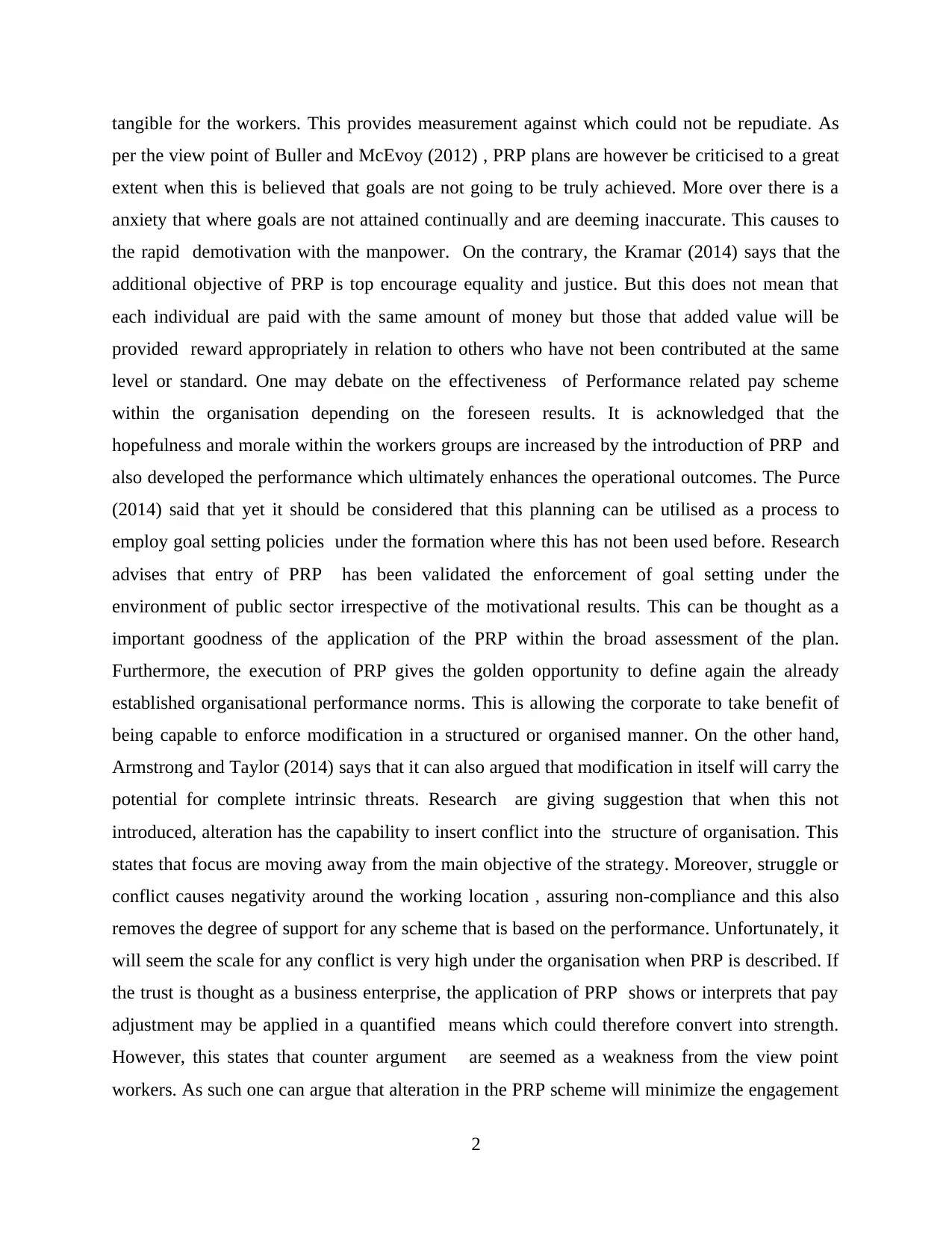
tangible for the workers. This provides measurement against which could not be repudiate. As
per the view point of Buller and McEvoy (2012) , PRP plans are however be criticised to a great
extent when this is believed that goals are not going to be truly achieved. More over there is a
anxiety that where goals are not attained continually and are deeming inaccurate. This causes to
the rapid demotivation with the manpower. On the contrary, the Kramar (2014) says that the
additional objective of PRP is top encourage equality and justice. But this does not mean that
each individual are paid with the same amount of money but those that added value will be
provided reward appropriately in relation to others who have not been contributed at the same
level or standard. One may debate on the effectiveness of Performance related pay scheme
within the organisation depending on the foreseen results. It is acknowledged that the
hopefulness and morale within the workers groups are increased by the introduction of PRP and
also developed the performance which ultimately enhances the operational outcomes. The Purce
(2014) said that yet it should be considered that this planning can be utilised as a process to
employ goal setting policies under the formation where this has not been used before. Research
advises that entry of PRP has been validated the enforcement of goal setting under the
environment of public sector irrespective of the motivational results. This can be thought as a
important goodness of the application of the PRP within the broad assessment of the plan.
Furthermore, the execution of PRP gives the golden opportunity to define again the already
established organisational performance norms. This is allowing the corporate to take benefit of
being capable to enforce modification in a structured or organised manner. On the other hand,
Armstrong and Taylor (2014) says that it can also argued that modification in itself will carry the
potential for complete intrinsic threats. Research are giving suggestion that when this not
introduced, alteration has the capability to insert conflict into the structure of organisation. This
states that focus are moving away from the main objective of the strategy. Moreover, struggle or
conflict causes negativity around the working location , assuring non-compliance and this also
removes the degree of support for any scheme that is based on the performance. Unfortunately, it
will seem the scale for any conflict is very high under the organisation when PRP is described. If
the trust is thought as a business enterprise, the application of PRP shows or interprets that pay
adjustment may be applied in a quantified means which could therefore convert into strength.
However, this states that counter argument are seemed as a weakness from the view point
workers. As such one can argue that alteration in the PRP scheme will minimize the engagement
2
per the view point of Buller and McEvoy (2012) , PRP plans are however be criticised to a great
extent when this is believed that goals are not going to be truly achieved. More over there is a
anxiety that where goals are not attained continually and are deeming inaccurate. This causes to
the rapid demotivation with the manpower. On the contrary, the Kramar (2014) says that the
additional objective of PRP is top encourage equality and justice. But this does not mean that
each individual are paid with the same amount of money but those that added value will be
provided reward appropriately in relation to others who have not been contributed at the same
level or standard. One may debate on the effectiveness of Performance related pay scheme
within the organisation depending on the foreseen results. It is acknowledged that the
hopefulness and morale within the workers groups are increased by the introduction of PRP and
also developed the performance which ultimately enhances the operational outcomes. The Purce
(2014) said that yet it should be considered that this planning can be utilised as a process to
employ goal setting policies under the formation where this has not been used before. Research
advises that entry of PRP has been validated the enforcement of goal setting under the
environment of public sector irrespective of the motivational results. This can be thought as a
important goodness of the application of the PRP within the broad assessment of the plan.
Furthermore, the execution of PRP gives the golden opportunity to define again the already
established organisational performance norms. This is allowing the corporate to take benefit of
being capable to enforce modification in a structured or organised manner. On the other hand,
Armstrong and Taylor (2014) says that it can also argued that modification in itself will carry the
potential for complete intrinsic threats. Research are giving suggestion that when this not
introduced, alteration has the capability to insert conflict into the structure of organisation. This
states that focus are moving away from the main objective of the strategy. Moreover, struggle or
conflict causes negativity around the working location , assuring non-compliance and this also
removes the degree of support for any scheme that is based on the performance. Unfortunately, it
will seem the scale for any conflict is very high under the organisation when PRP is described. If
the trust is thought as a business enterprise, the application of PRP shows or interprets that pay
adjustment may be applied in a quantified means which could therefore convert into strength.
However, this states that counter argument are seemed as a weakness from the view point
workers. As such one can argue that alteration in the PRP scheme will minimize the engagement
2
Paraphrase This Document
Need a fresh take? Get an instant paraphrase of this document with our AI Paraphraser
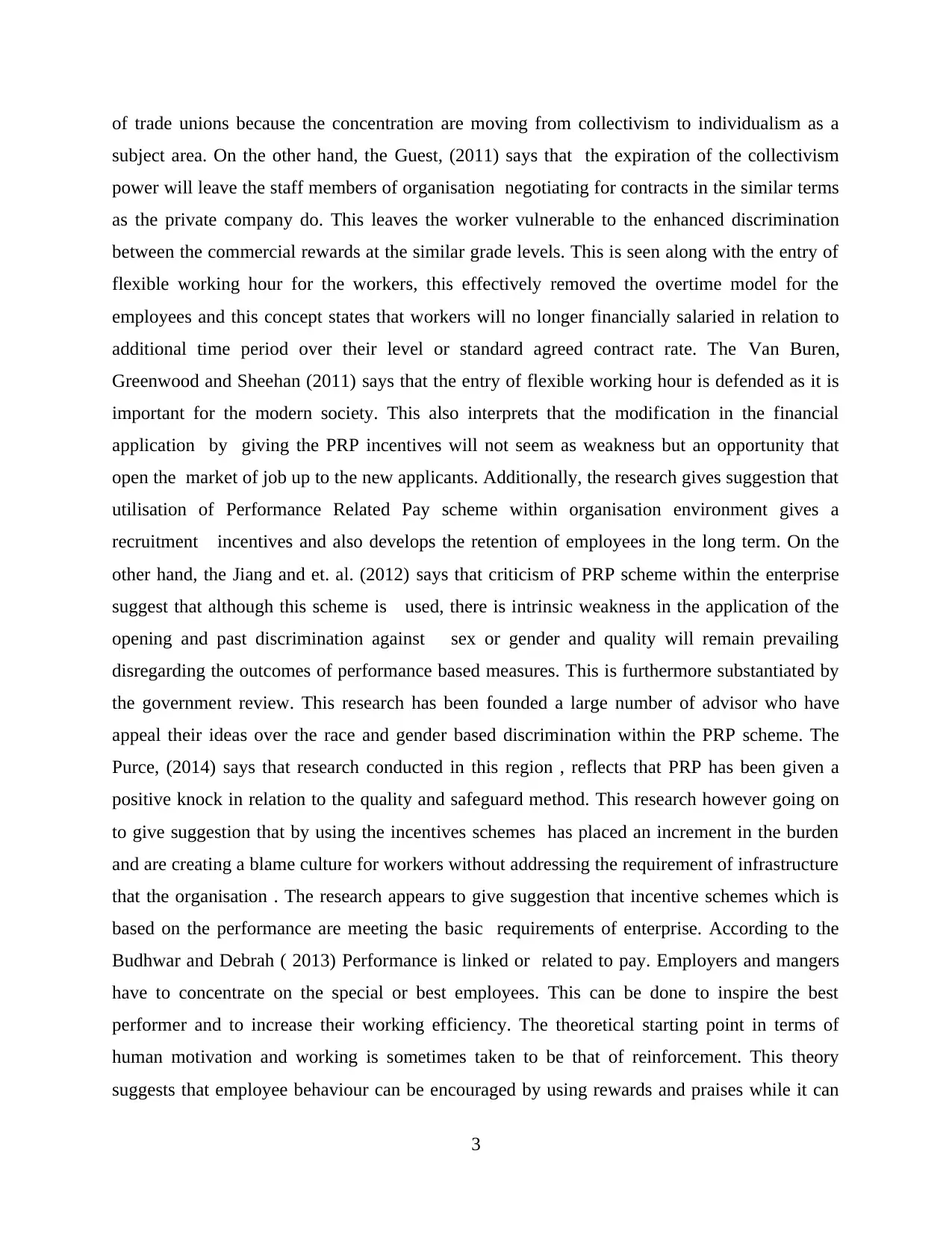
of trade unions because the concentration are moving from collectivism to individualism as a
subject area. On the other hand, the Guest, (2011) says that the expiration of the collectivism
power will leave the staff members of organisation negotiating for contracts in the similar terms
as the private company do. This leaves the worker vulnerable to the enhanced discrimination
between the commercial rewards at the similar grade levels. This is seen along with the entry of
flexible working hour for the workers, this effectively removed the overtime model for the
employees and this concept states that workers will no longer financially salaried in relation to
additional time period over their level or standard agreed contract rate. The Van Buren,
Greenwood and Sheehan (2011) says that the entry of flexible working hour is defended as it is
important for the modern society. This also interprets that the modification in the financial
application by giving the PRP incentives will not seem as weakness but an opportunity that
open the market of job up to the new applicants. Additionally, the research gives suggestion that
utilisation of Performance Related Pay scheme within organisation environment gives a
recruitment incentives and also develops the retention of employees in the long term. On the
other hand, the Jiang and et. al. (2012) says that criticism of PRP scheme within the enterprise
suggest that although this scheme is used, there is intrinsic weakness in the application of the
opening and past discrimination against sex or gender and quality will remain prevailing
disregarding the outcomes of performance based measures. This is furthermore substantiated by
the government review. This research has been founded a large number of advisor who have
appeal their ideas over the race and gender based discrimination within the PRP scheme. The
Purce, (2014) says that research conducted in this region , reflects that PRP has been given a
positive knock in relation to the quality and safeguard method. This research however going on
to give suggestion that by using the incentives schemes has placed an increment in the burden
and are creating a blame culture for workers without addressing the requirement of infrastructure
that the organisation . The research appears to give suggestion that incentive schemes which is
based on the performance are meeting the basic requirements of enterprise. According to the
Budhwar and Debrah ( 2013) Performance is linked or related to pay. Employers and mangers
have to concentrate on the special or best employees. This can be done to inspire the best
performer and to increase their working efficiency. The theoretical starting point in terms of
human motivation and working is sometimes taken to be that of reinforcement. This theory
suggests that employee behaviour can be encouraged by using rewards and praises while it can
3
subject area. On the other hand, the Guest, (2011) says that the expiration of the collectivism
power will leave the staff members of organisation negotiating for contracts in the similar terms
as the private company do. This leaves the worker vulnerable to the enhanced discrimination
between the commercial rewards at the similar grade levels. This is seen along with the entry of
flexible working hour for the workers, this effectively removed the overtime model for the
employees and this concept states that workers will no longer financially salaried in relation to
additional time period over their level or standard agreed contract rate. The Van Buren,
Greenwood and Sheehan (2011) says that the entry of flexible working hour is defended as it is
important for the modern society. This also interprets that the modification in the financial
application by giving the PRP incentives will not seem as weakness but an opportunity that
open the market of job up to the new applicants. Additionally, the research gives suggestion that
utilisation of Performance Related Pay scheme within organisation environment gives a
recruitment incentives and also develops the retention of employees in the long term. On the
other hand, the Jiang and et. al. (2012) says that criticism of PRP scheme within the enterprise
suggest that although this scheme is used, there is intrinsic weakness in the application of the
opening and past discrimination against sex or gender and quality will remain prevailing
disregarding the outcomes of performance based measures. This is furthermore substantiated by
the government review. This research has been founded a large number of advisor who have
appeal their ideas over the race and gender based discrimination within the PRP scheme. The
Purce, (2014) says that research conducted in this region , reflects that PRP has been given a
positive knock in relation to the quality and safeguard method. This research however going on
to give suggestion that by using the incentives schemes has placed an increment in the burden
and are creating a blame culture for workers without addressing the requirement of infrastructure
that the organisation . The research appears to give suggestion that incentive schemes which is
based on the performance are meeting the basic requirements of enterprise. According to the
Budhwar and Debrah ( 2013) Performance is linked or related to pay. Employers and mangers
have to concentrate on the special or best employees. This can be done to inspire the best
performer and to increase their working efficiency. The theoretical starting point in terms of
human motivation and working is sometimes taken to be that of reinforcement. This theory
suggests that employee behaviour can be encouraged by using rewards and praises while it can
3
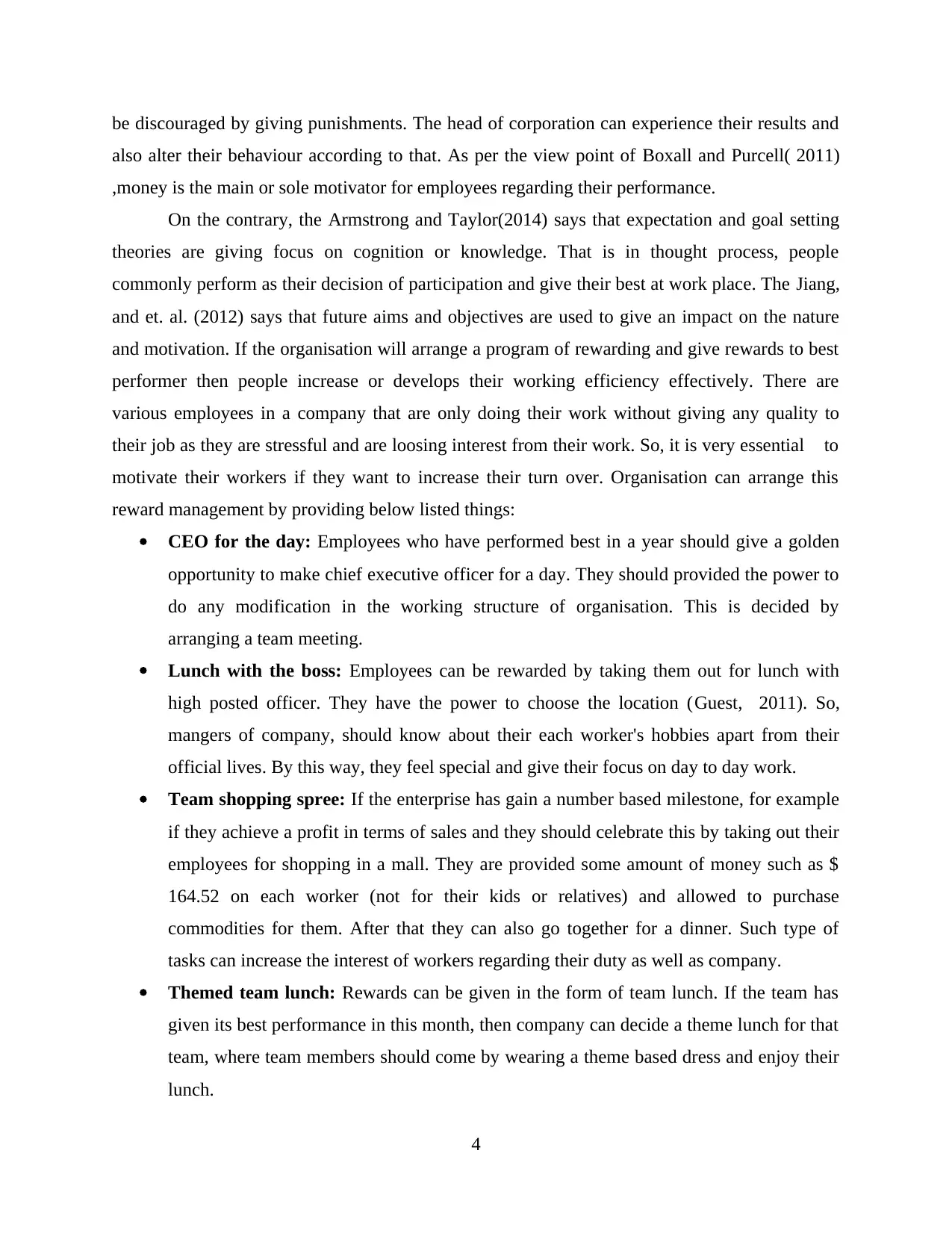
be discouraged by giving punishments. The head of corporation can experience their results and
also alter their behaviour according to that. As per the view point of Boxall and Purcell( 2011)
,money is the main or sole motivator for employees regarding their performance.
On the contrary, the Armstrong and Taylor(2014) says that expectation and goal setting
theories are giving focus on cognition or knowledge. That is in thought process, people
commonly perform as their decision of participation and give their best at work place. The Jiang,
and et. al. (2012) says that future aims and objectives are used to give an impact on the nature
and motivation. If the organisation will arrange a program of rewarding and give rewards to best
performer then people increase or develops their working efficiency effectively. There are
various employees in a company that are only doing their work without giving any quality to
their job as they are stressful and are loosing interest from their work. So, it is very essential to
motivate their workers if they want to increase their turn over. Organisation can arrange this
reward management by providing below listed things:
CEO for the day: Employees who have performed best in a year should give a golden
opportunity to make chief executive officer for a day. They should provided the power to
do any modification in the working structure of organisation. This is decided by
arranging a team meeting.
Lunch with the boss: Employees can be rewarded by taking them out for lunch with
high posted officer. They have the power to choose the location (Guest, 2011). So,
mangers of company, should know about their each worker's hobbies apart from their
official lives. By this way, they feel special and give their focus on day to day work.
Team shopping spree: If the enterprise has gain a number based milestone, for example
if they achieve a profit in terms of sales and they should celebrate this by taking out their
employees for shopping in a mall. They are provided some amount of money such as $
164.52 on each worker (not for their kids or relatives) and allowed to purchase
commodities for them. After that they can also go together for a dinner. Such type of
tasks can increase the interest of workers regarding their duty as well as company.
Themed team lunch: Rewards can be given in the form of team lunch. If the team has
given its best performance in this month, then company can decide a theme lunch for that
team, where team members should come by wearing a theme based dress and enjoy their
lunch.
4
also alter their behaviour according to that. As per the view point of Boxall and Purcell( 2011)
,money is the main or sole motivator for employees regarding their performance.
On the contrary, the Armstrong and Taylor(2014) says that expectation and goal setting
theories are giving focus on cognition or knowledge. That is in thought process, people
commonly perform as their decision of participation and give their best at work place. The Jiang,
and et. al. (2012) says that future aims and objectives are used to give an impact on the nature
and motivation. If the organisation will arrange a program of rewarding and give rewards to best
performer then people increase or develops their working efficiency effectively. There are
various employees in a company that are only doing their work without giving any quality to
their job as they are stressful and are loosing interest from their work. So, it is very essential to
motivate their workers if they want to increase their turn over. Organisation can arrange this
reward management by providing below listed things:
CEO for the day: Employees who have performed best in a year should give a golden
opportunity to make chief executive officer for a day. They should provided the power to
do any modification in the working structure of organisation. This is decided by
arranging a team meeting.
Lunch with the boss: Employees can be rewarded by taking them out for lunch with
high posted officer. They have the power to choose the location (Guest, 2011). So,
mangers of company, should know about their each worker's hobbies apart from their
official lives. By this way, they feel special and give their focus on day to day work.
Team shopping spree: If the enterprise has gain a number based milestone, for example
if they achieve a profit in terms of sales and they should celebrate this by taking out their
employees for shopping in a mall. They are provided some amount of money such as $
164.52 on each worker (not for their kids or relatives) and allowed to purchase
commodities for them. After that they can also go together for a dinner. Such type of
tasks can increase the interest of workers regarding their duty as well as company.
Themed team lunch: Rewards can be given in the form of team lunch. If the team has
given its best performance in this month, then company can decide a theme lunch for that
team, where team members should come by wearing a theme based dress and enjoy their
lunch.
4
⊘ This is a preview!⊘
Do you want full access?
Subscribe today to unlock all pages.

Trusted by 1+ million students worldwide
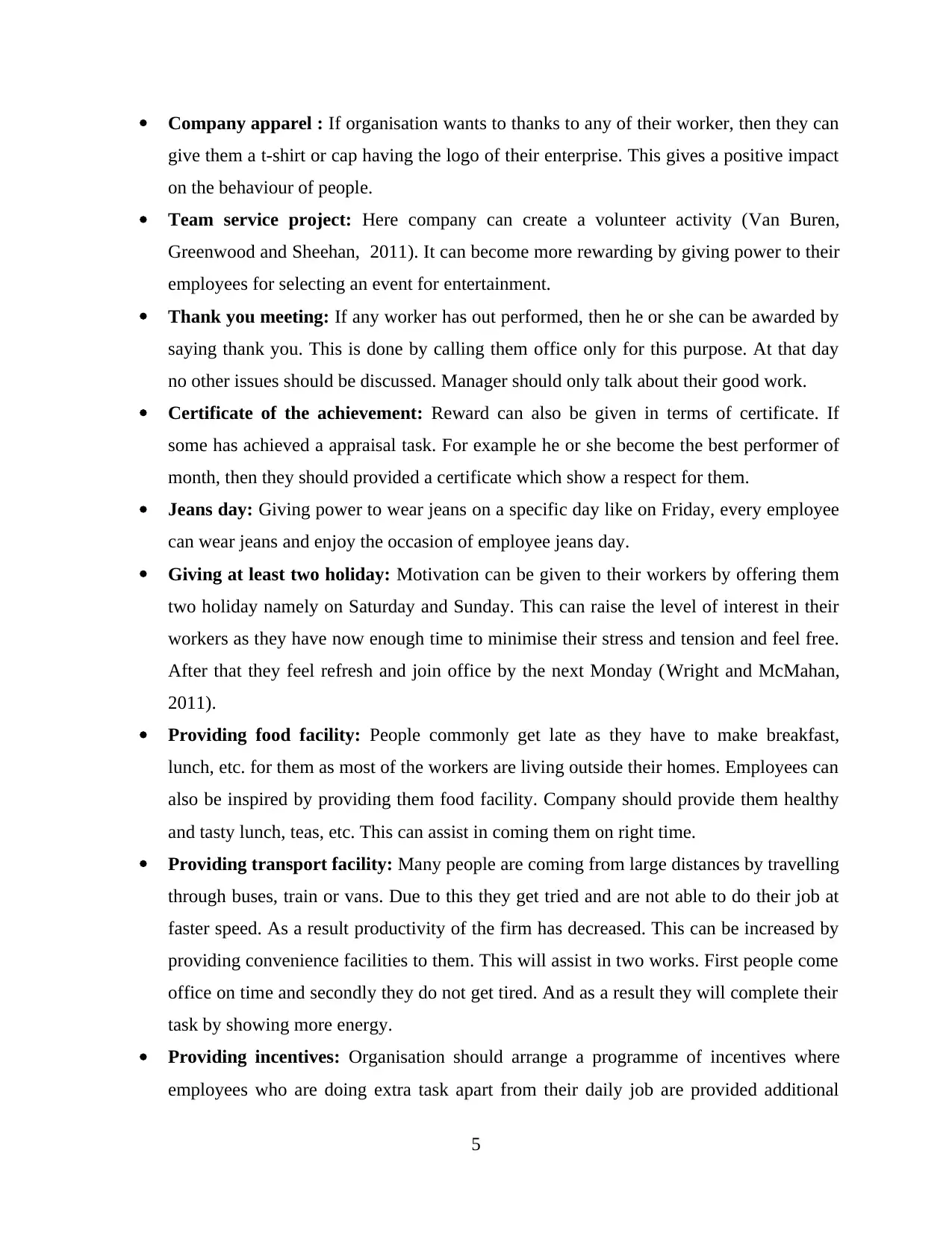
Company apparel : If organisation wants to thanks to any of their worker, then they can
give them a t-shirt or cap having the logo of their enterprise. This gives a positive impact
on the behaviour of people.
Team service project: Here company can create a volunteer activity (Van Buren,
Greenwood and Sheehan, 2011). It can become more rewarding by giving power to their
employees for selecting an event for entertainment.
Thank you meeting: If any worker has out performed, then he or she can be awarded by
saying thank you. This is done by calling them office only for this purpose. At that day
no other issues should be discussed. Manager should only talk about their good work.
Certificate of the achievement: Reward can also be given in terms of certificate. If
some has achieved a appraisal task. For example he or she become the best performer of
month, then they should provided a certificate which show a respect for them.
Jeans day: Giving power to wear jeans on a specific day like on Friday, every employee
can wear jeans and enjoy the occasion of employee jeans day.
Giving at least two holiday: Motivation can be given to their workers by offering them
two holiday namely on Saturday and Sunday. This can raise the level of interest in their
workers as they have now enough time to minimise their stress and tension and feel free.
After that they feel refresh and join office by the next Monday (Wright and McMahan,
2011).
Providing food facility: People commonly get late as they have to make breakfast,
lunch, etc. for them as most of the workers are living outside their homes. Employees can
also be inspired by providing them food facility. Company should provide them healthy
and tasty lunch, teas, etc. This can assist in coming them on right time.
Providing transport facility: Many people are coming from large distances by travelling
through buses, train or vans. Due to this they get tried and are not able to do their job at
faster speed. As a result productivity of the firm has decreased. This can be increased by
providing convenience facilities to them. This will assist in two works. First people come
office on time and secondly they do not get tired. And as a result they will complete their
task by showing more energy.
Providing incentives: Organisation should arrange a programme of incentives where
employees who are doing extra task apart from their daily job are provided additional
5
give them a t-shirt or cap having the logo of their enterprise. This gives a positive impact
on the behaviour of people.
Team service project: Here company can create a volunteer activity (Van Buren,
Greenwood and Sheehan, 2011). It can become more rewarding by giving power to their
employees for selecting an event for entertainment.
Thank you meeting: If any worker has out performed, then he or she can be awarded by
saying thank you. This is done by calling them office only for this purpose. At that day
no other issues should be discussed. Manager should only talk about their good work.
Certificate of the achievement: Reward can also be given in terms of certificate. If
some has achieved a appraisal task. For example he or she become the best performer of
month, then they should provided a certificate which show a respect for them.
Jeans day: Giving power to wear jeans on a specific day like on Friday, every employee
can wear jeans and enjoy the occasion of employee jeans day.
Giving at least two holiday: Motivation can be given to their workers by offering them
two holiday namely on Saturday and Sunday. This can raise the level of interest in their
workers as they have now enough time to minimise their stress and tension and feel free.
After that they feel refresh and join office by the next Monday (Wright and McMahan,
2011).
Providing food facility: People commonly get late as they have to make breakfast,
lunch, etc. for them as most of the workers are living outside their homes. Employees can
also be inspired by providing them food facility. Company should provide them healthy
and tasty lunch, teas, etc. This can assist in coming them on right time.
Providing transport facility: Many people are coming from large distances by travelling
through buses, train or vans. Due to this they get tried and are not able to do their job at
faster speed. As a result productivity of the firm has decreased. This can be increased by
providing convenience facilities to them. This will assist in two works. First people come
office on time and secondly they do not get tired. And as a result they will complete their
task by showing more energy.
Providing incentives: Organisation should arrange a programme of incentives where
employees who are doing extra task apart from their daily job are provided additional
5
Paraphrase This Document
Need a fresh take? Get an instant paraphrase of this document with our AI Paraphraser
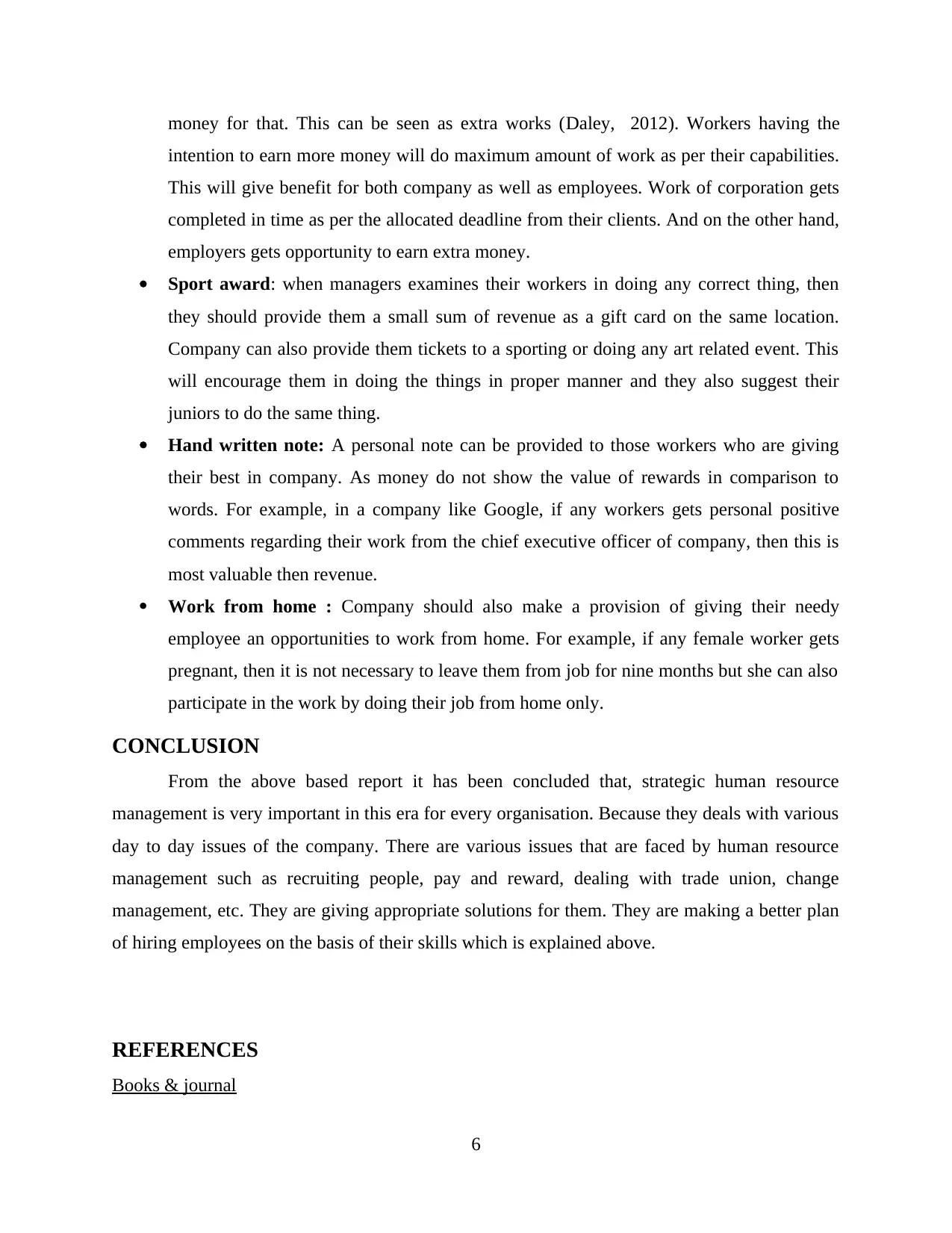
money for that. This can be seen as extra works (Daley, 2012). Workers having the
intention to earn more money will do maximum amount of work as per their capabilities.
This will give benefit for both company as well as employees. Work of corporation gets
completed in time as per the allocated deadline from their clients. And on the other hand,
employers gets opportunity to earn extra money.
Sport award: when managers examines their workers in doing any correct thing, then
they should provide them a small sum of revenue as a gift card on the same location.
Company can also provide them tickets to a sporting or doing any art related event. This
will encourage them in doing the things in proper manner and they also suggest their
juniors to do the same thing.
Hand written note: A personal note can be provided to those workers who are giving
their best in company. As money do not show the value of rewards in comparison to
words. For example, in a company like Google, if any workers gets personal positive
comments regarding their work from the chief executive officer of company, then this is
most valuable then revenue.
Work from home : Company should also make a provision of giving their needy
employee an opportunities to work from home. For example, if any female worker gets
pregnant, then it is not necessary to leave them from job for nine months but she can also
participate in the work by doing their job from home only.
CONCLUSION
From the above based report it has been concluded that, strategic human resource
management is very important in this era for every organisation. Because they deals with various
day to day issues of the company. There are various issues that are faced by human resource
management such as recruiting people, pay and reward, dealing with trade union, change
management, etc. They are giving appropriate solutions for them. They are making a better plan
of hiring employees on the basis of their skills which is explained above.
REFERENCES
Books & journal
6
intention to earn more money will do maximum amount of work as per their capabilities.
This will give benefit for both company as well as employees. Work of corporation gets
completed in time as per the allocated deadline from their clients. And on the other hand,
employers gets opportunity to earn extra money.
Sport award: when managers examines their workers in doing any correct thing, then
they should provide them a small sum of revenue as a gift card on the same location.
Company can also provide them tickets to a sporting or doing any art related event. This
will encourage them in doing the things in proper manner and they also suggest their
juniors to do the same thing.
Hand written note: A personal note can be provided to those workers who are giving
their best in company. As money do not show the value of rewards in comparison to
words. For example, in a company like Google, if any workers gets personal positive
comments regarding their work from the chief executive officer of company, then this is
most valuable then revenue.
Work from home : Company should also make a provision of giving their needy
employee an opportunities to work from home. For example, if any female worker gets
pregnant, then it is not necessary to leave them from job for nine months but she can also
participate in the work by doing their job from home only.
CONCLUSION
From the above based report it has been concluded that, strategic human resource
management is very important in this era for every organisation. Because they deals with various
day to day issues of the company. There are various issues that are faced by human resource
management such as recruiting people, pay and reward, dealing with trade union, change
management, etc. They are giving appropriate solutions for them. They are making a better plan
of hiring employees on the basis of their skills which is explained above.
REFERENCES
Books & journal
6
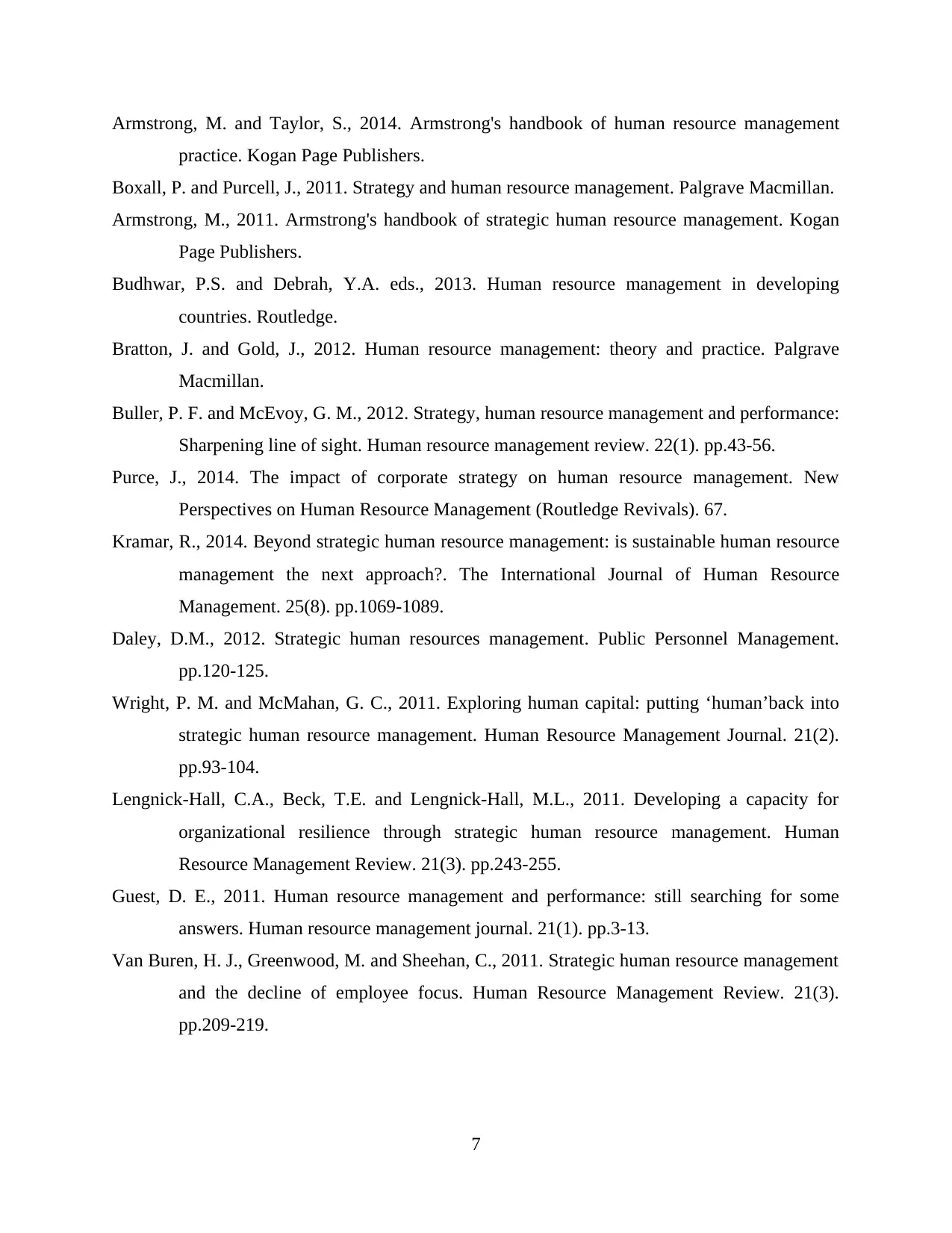
Armstrong, M. and Taylor, S., 2014. Armstrong's handbook of human resource management
practice. Kogan Page Publishers.
Boxall, P. and Purcell, J., 2011. Strategy and human resource management. Palgrave Macmillan.
Armstrong, M., 2011. Armstrong's handbook of strategic human resource management. Kogan
Page Publishers.
Budhwar, P.S. and Debrah, Y.A. eds., 2013. Human resource management in developing
countries. Routledge.
Bratton, J. and Gold, J., 2012. Human resource management: theory and practice. Palgrave
Macmillan.
Buller, P. F. and McEvoy, G. M., 2012. Strategy, human resource management and performance:
Sharpening line of sight. Human resource management review. 22(1). pp.43-56.
Purce, J., 2014. The impact of corporate strategy on human resource management. New
Perspectives on Human Resource Management (Routledge Revivals). 67.
Kramar, R., 2014. Beyond strategic human resource management: is sustainable human resource
management the next approach?. The International Journal of Human Resource
Management. 25(8). pp.1069-1089.
Daley, D.M., 2012. Strategic human resources management. Public Personnel Management.
pp.120-125.
Wright, P. M. and McMahan, G. C., 2011. Exploring human capital: putting ‘human’back into
strategic human resource management. Human Resource Management Journal. 21(2).
pp.93-104.
Lengnick-Hall, C.A., Beck, T.E. and Lengnick-Hall, M.L., 2011. Developing a capacity for
organizational resilience through strategic human resource management. Human
Resource Management Review. 21(3). pp.243-255.
Guest, D. E., 2011. Human resource management and performance: still searching for some
answers. Human resource management journal. 21(1). pp.3-13.
Van Buren, H. J., Greenwood, M. and Sheehan, C., 2011. Strategic human resource management
and the decline of employee focus. Human Resource Management Review. 21(3).
pp.209-219.
7
practice. Kogan Page Publishers.
Boxall, P. and Purcell, J., 2011. Strategy and human resource management. Palgrave Macmillan.
Armstrong, M., 2011. Armstrong's handbook of strategic human resource management. Kogan
Page Publishers.
Budhwar, P.S. and Debrah, Y.A. eds., 2013. Human resource management in developing
countries. Routledge.
Bratton, J. and Gold, J., 2012. Human resource management: theory and practice. Palgrave
Macmillan.
Buller, P. F. and McEvoy, G. M., 2012. Strategy, human resource management and performance:
Sharpening line of sight. Human resource management review. 22(1). pp.43-56.
Purce, J., 2014. The impact of corporate strategy on human resource management. New
Perspectives on Human Resource Management (Routledge Revivals). 67.
Kramar, R., 2014. Beyond strategic human resource management: is sustainable human resource
management the next approach?. The International Journal of Human Resource
Management. 25(8). pp.1069-1089.
Daley, D.M., 2012. Strategic human resources management. Public Personnel Management.
pp.120-125.
Wright, P. M. and McMahan, G. C., 2011. Exploring human capital: putting ‘human’back into
strategic human resource management. Human Resource Management Journal. 21(2).
pp.93-104.
Lengnick-Hall, C.A., Beck, T.E. and Lengnick-Hall, M.L., 2011. Developing a capacity for
organizational resilience through strategic human resource management. Human
Resource Management Review. 21(3). pp.243-255.
Guest, D. E., 2011. Human resource management and performance: still searching for some
answers. Human resource management journal. 21(1). pp.3-13.
Van Buren, H. J., Greenwood, M. and Sheehan, C., 2011. Strategic human resource management
and the decline of employee focus. Human Resource Management Review. 21(3).
pp.209-219.
7
⊘ This is a preview!⊘
Do you want full access?
Subscribe today to unlock all pages.

Trusted by 1+ million students worldwide
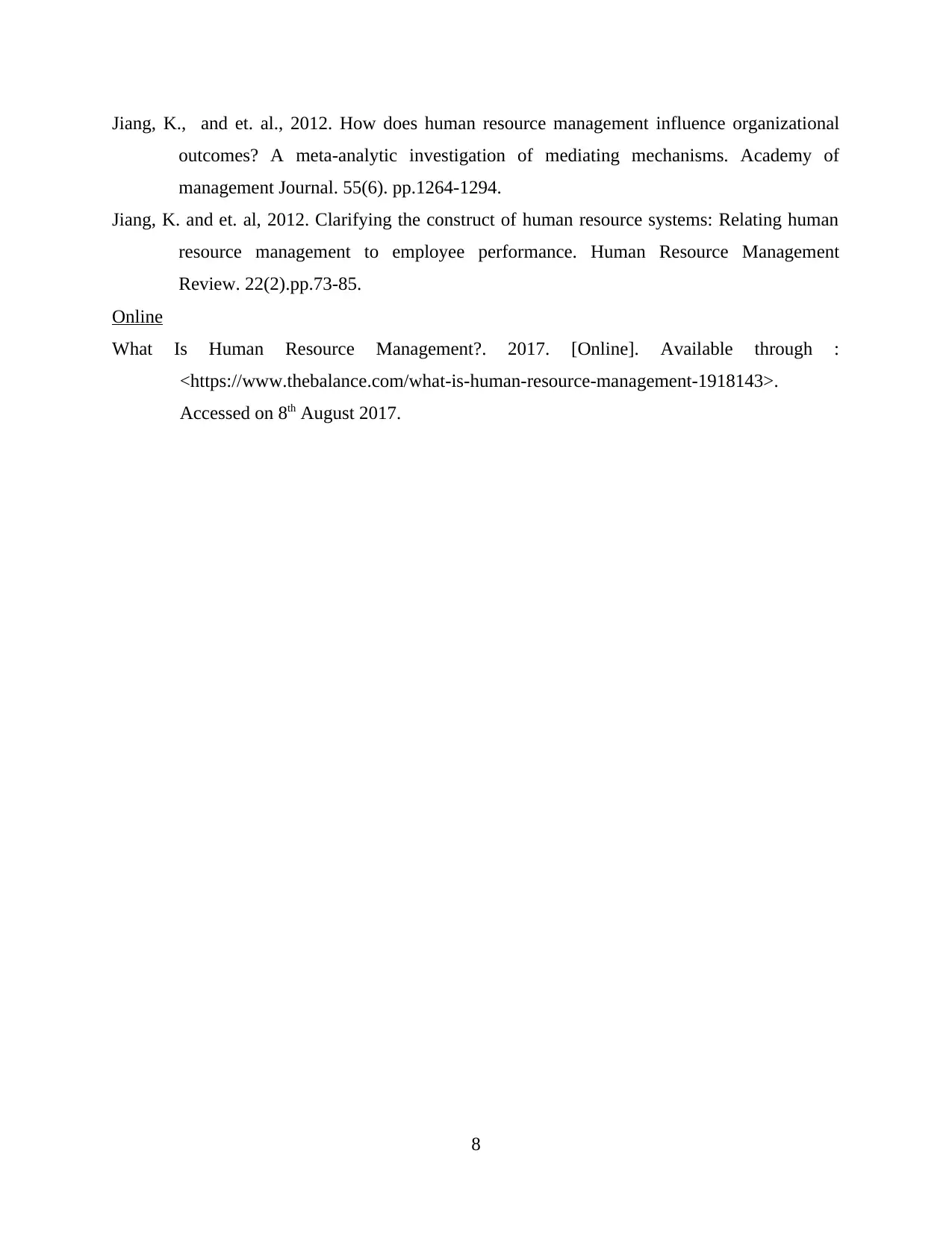
Jiang, K., and et. al., 2012. How does human resource management influence organizational
outcomes? A meta-analytic investigation of mediating mechanisms. Academy of
management Journal. 55(6). pp.1264-1294.
Jiang, K. and et. al, 2012. Clarifying the construct of human resource systems: Relating human
resource management to employee performance. Human Resource Management
Review. 22(2).pp.73-85.
Online
What Is Human Resource Management?. 2017. [Online]. Available through :
<https://www.thebalance.com/what-is-human-resource-management-1918143>.
Accessed on 8th August 2017.
8
outcomes? A meta-analytic investigation of mediating mechanisms. Academy of
management Journal. 55(6). pp.1264-1294.
Jiang, K. and et. al, 2012. Clarifying the construct of human resource systems: Relating human
resource management to employee performance. Human Resource Management
Review. 22(2).pp.73-85.
Online
What Is Human Resource Management?. 2017. [Online]. Available through :
<https://www.thebalance.com/what-is-human-resource-management-1918143>.
Accessed on 8th August 2017.
8
1 out of 10
Related Documents
Your All-in-One AI-Powered Toolkit for Academic Success.
+13062052269
info@desklib.com
Available 24*7 on WhatsApp / Email
![[object Object]](/_next/static/media/star-bottom.7253800d.svg)
Unlock your academic potential
Copyright © 2020–2025 A2Z Services. All Rights Reserved. Developed and managed by ZUCOL.





